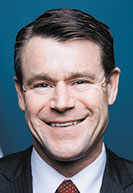Subscriber Benefit
As a subscriber you can listen to articles at work, in the car, or while you work out. Subscribe Now
The deal announced last week that landed the state its largest-ever capital investment commitment was two years in the making—a journey that saw state and federal officials travel overseas to make the case that Indiana would be the best fit for a sizable investment.
South Korean chip manufacturer SK Hynix Inc. on April 3 said it will spend $3.87 billion to establish a new semiconductor packaging facility at the Purdue Research Park in West Lafayette, with a 430,000-square-foot building spanning 90 acres. The facility, set to open in the second half of 2028, is expected to employ at least 800 people by 2030, but that figure could grow to more than 1,000.
“We are excited to build a state-of-the-art advanced packaging facility in Indiana,” SK Hynix CEO Kwak Noh-Jung said in a news release. “We believe this project will lay the foundation for a new Silicon Heartland, a semiconductor ecosystem centered in the Midwest Triangle. This facility will create local, high-paying jobs and produce AI memory chips with unmatched capabilities, so that America can onshore more of its critical chip supply chain.”
But while the company’s announcement has made waves across Indiana over the past week, so too has a decision by another firm, Minnesota-based SkyWater Technology, which canceled its project at Purdue after the federal funding on which it based its planned $1.8 billion investment in West Lafayette wasn’t granted to the company.
A hefty endeavor

Ann Lathrop, chief strategy officer for the Indiana Economic Development Corp., told IBJ it’s impossible to credit a single moment for Indiana’s landing of SK Hynix. “There were multiple touch points from many within the Indiana eco-system to the company” that collectively resulted in the firm saying “yes” to Indiana, she said.
In fact, courtship of the manufacturer—the second-largest company in South Korea—began in early 2022, around the time the IEDC was starting to roll out its strategy focused on trying to make Indiana an epicenter of semiconductor production and distribution in the United States.
And while Lathrop declined to share specifics of the state’s efforts to woo SK Hynix, she said the strategy involved a mix of one-on-one discussions and larger group conversations with the company, held both in person and virtually. She said it would “be a challenge” to lay out every interaction the IEDC and its partners had with the company throughout the process—and it isn’t willing to divulge most of those details, anyway, unless SK Hynix indicated it would discuss the matter publicly.
Representatives for SK Hynix did not respond to several questions sent by email ahead of this story going to print.
Lathrop also declined to share whether other locations across the state were considered by SK Hynix, citing the information as a “deliberative process” of the company that the IEDC considers confidential.

But officials say it was early in the process that the state brought in Purdue’s then-president, Mitch Daniels, and Mung Chiang, at the time the university’s engineering dean and vice president of strategic initiatives, to be involved in efforts to help land the company.
The Purdue Research Foundation, Ivy Tech Community College, various utility companies and the city of West Lafayette were also involved in the effort.
“It does take the whole village, and it’s like a two-year tournament,” Chiang told IBJ, likening the process to basketball, another area where Purdue has seen success in recent years. “A company as big as SK is looking at many states in the country, and we had to go through many rounds. Indiana was one of the Final Four. I won’t tell you what the other three might have been, but we prevailed in the end.”
Chiang said Purdue’s pitch focused on the school’s talent pipeline and commitment to innovation, while highlighting the ability of state and local government and higher education institutions to collaborate.
“We’ve got the infrastructure, we’ve got the workforce and we’ve got the innovation to work together and make your business successful here,” he said. “There’s a reason why SK Hynix is No. 1 in the world in AI memory chips, because they innovate and they want to work with the best innovators in the country.”
The IEDC brought in Purdue and the other reinforcements to land SK Hynix in the spring of 2022, coinciding with the inaugural Indiana Global Economic Summit that May, which offered attendees a broad-stroke preview of the IEDC’s strategy to bring in new companies and an opportunity to network with state leaders.
That event was timed with other key economic development announcements, including Eli Lilly and Co.’s decision to locate a manufacturing campus at the state’s LEAP Lebanon Research and Innovation District as well as the IEDC’s launch of a task force, known as Accelerating Microelectronics Production & Development, or AMPD, focused on attracting semiconductor manufacturing to the state.

CHIPS on the table
State leaders weren’t alone in their efforts to bring SK Hynix and other semiconductor companies to Indiana.

It was around that time that U.S. Sen. Todd Young, R-Ind., was working closely with political allies both in his own party and across the aisle to find a way forward for the abandoned Endless Frontier Act, a bill he introduced in 2019 that aimed to reestablish the United States as a global innovation leader. That legislation had given way to the Innovation and Competition Act, which Young coauthored with Sen. Chuck Schumer, D-New York. But the bill did not receive a vote in the House, leaving the legislation’s future uncertain.
Eventually, the House and Senate settled on the CHIPS & Science Act, which put an increased focus on domestic manufacturing of semiconductors—setting aside $52.7 billion in subsidies and a 25% tax credit for companies that build chip plants, called fabs, in the United States.
Young said fighting for the legislation took some political capital, but it’s a move he’s confident has helped bring tens of billions of dollars in investment in the sector to the United States—and billions to Indiana—and will yield billions more in the years ahead.
“It was not an easy argument to make to conservative Republicans at a time when we are appropriately watching our finances very closely, but [we] persuaded enough colleagues that this was a necessary investment for our national security, for our economic security and for our future growth,” Young told IBJ. “And we finally got it done.”
President Joe Biden signed the CHIPS bill into law on Aug. 9, 2023, two weeks after SK Hynix shared in a meeting at the White House that it would invest $22 billion in U.S. production and packaging operations for semiconductors and other microelectronics.
Just a few weeks later, Gov. Eric Holcomb, then-Secretary of Commerce Brad Chambers, Chiang and several other dignitaries traveled overseas as part of a six-day visit to Taiwan and South Korea to meet with business leaders, university officials and government representatives. The group made its pitch to SK Hynix in person.
“We’re in perpetual motion, and that’s whether they’re here or we’re there,” Holcomb said of the value of traveling overseas. “It’s a small world, but relationships matter, earning trust matters, delivering on what you say matters.
“You can only do so much across an ocean when that ocean separates you, but when you’re together, there’s been much gain,” he said. “We’re talking with the global elite now who want to excel in their sector, and that’s put Indiana truly as a leader in this heartland and the Silicon Heartland it’s becoming.”
A year later, Young took a trip of his own to South Korea to visit with the company’s leaders. And in December, he met again with SK Group Chair Chey Tae-won, who was visiting Salamander Middleburg Resort & Spa in Virginia, 50 miles west of Washington, D.C.
“Because their investment would fall under the CHIPS & Science Act, and I felt very much committed to making this work for the people of Indiana, I flew to South Korea and I had dinner with the company’s chairman,” Young told IBJ, recalling the encounters. “I then visited with the chairman after he indicated he was going to be in the United States at a retreat. It was a fairly intensive effort, and everyone did their part.”
A big incentive
Those visits by Young were ancillary but additive to a drawn-out, year-and-a-half-long strategy by the state following Holcomb’s overseas trip to secure a deal with the firm for a sizable investment. In addition to face-to-face meetings, the effort also included numerous follow-up phone calls, video conferences and email exchanges, officials said.
The agreement to locate the project in West Lafayette was not finalized between SK Hynix and the IEDC until after a February story by the London-based Financial Times reported that Indiana had beaten out Arizona for the project.
Erin Easter, mayor of West Lafayette, told the “Based in Lafayette” news outlet that it wasn’t clear the city and Purdue were still under consideration until after that story was published. Around that time, leaders in Lebanon said publicly that the 9,000-acre LEAP District was not being considered for the project.
The plant will house an advanced semiconductor packaging production line that will mass produce next-generation high-bandwidth memory, or HBM, chips, which are a critical component of graphic processing units that train AI systems such as ChatGPT. It will be the first-of-its-kind, large-scale facility in the United States
SK Hynix, which is the exclusive chips partner of Silicon Valley-based Nvidia for the company’s graphic-processor units, does not plan to produce semiconductors at the West Lafayette facility but rather package pre-built chips together for use in devices.
The commitment from SK Hynix marks the single-largest economic development deal in the state’s history, with up to $4.66 billion in capital investment on the table. In turn, that deal has garnered the most comprehensive incentive offering ever put forth by the IEDC, a package that totals almost $700 million.
The offer includes numerous elements, most of which are considered performance-based, meaning the company won’t receive the funds—or will have them clawed back—if it doesn’t meet established benchmarks. The deal includes:
◗ Up to nearly $554 million in Innovation Development District tax credits.
◗ $80 million in conditional structured performance payments.
◗ $45 million through the Industrial Development Grant Fund to support infrastructure improvements surrounding the new plant.
◗ $3 million in Manufacturing Readiness Grants.
◗ $3 million in training grants.
◗ Discounted land pricing for the project, which could expand by 30 acres.
The incentive package would amount to anywhere from $700,000 to $875,000 per job, depending on total employment. And those incentive figures do not take into consideration federal incentives the company is also expected to secure through the CHIPS & Science Act. However, officials told IBJ that the deal is not dependent on federal CHIPS funding.
Katie Culp is CEO of KSM Location Advisors, an Indianapolis-based firm that works on economic development deals across the country. She said the SK Hynix deal is good news for both Tippecanoe County and the state because it is attracting not only sizable investment to the state but attention. That interest, she said, could result in additional companies that see opportunity in Indiana, either to take on their own projects or to serve as suppliers for the packaging facility or other microelectronics firms.
“This really sets the stage for related industries that would serve and be connected to [SK Hynix], but it also proves we’re a solid location for that type of operation,” she said. “It kind of gets us on the map, from a more national standpoint, due to the size of the project.”

Big shift
Over the past two years, West Lafayette has grown to become a hub for semiconductor research and development.
Purdue University has inked multiple international agreements focused on advancing R&D and workforce development in the semiconductor industry. Those deals are with manufacturers and higher education institutions in Japan and Taiwan as well as the government of India and Belgium-based research and innovation center Imec. A year ago, the university announced it was investing $100 million in semiconductor research and learning facilities as part of its Purdue Computes initiative.
But SkyWater’s decision not to pursue its project in West Lafayette, which became public last week, could be a blow to the momentum the university and state have built in the semiconductor industry over the past two years. And with potential funding for its project no longer on the horizon, it’s unclear whether the company will ever make its plans for Indiana a reality.
“Currently, SkyWater does not have a definitive plan targeting new fab construction in Indiana, but we remain committed to growing the microelectronics ecosystem in the U.S. with emphasis on providing fab access and production support for emerging and strategic technologies,” company spokesperson Lauri Julian told IBJ in an emailed statement.
SkyWater, which bills itself as the only U.S.-investor-owned pure-play semiconductor and technology foundry, makes integrated circuits for Infineon, D-Wave, Microsoft and Stefipower. The company first announced plans for a 600,000-square-foot facility near Purdue in July 2022, saying at the time the plant would allow it to respond to increasing demand for domestic manufacturing of microelectronics.
The company said at the time, though, that the deal was dependent on the company winning funding from the CHIPS Act. But the company said it faces an “uncertain path” after federal regulators decided recently that research and design facilities would not be eligible for funding from the CHIPS Act.
That decision, announced last month, all but ensures SkyWater and other semiconductor research projects across the country will not receive funding they say is needed to get their projects off the ground.
“The status of this project comes after a comprehensive review of operations, market conditions, business model validation, SkyWater’s emphasis on technology development and CHIPS funding finalization,” Julian said.
In a statement, Erin Sweitzer, the IEDC’s deputy chief of staff, said the agency remains committed to helping SkyWater establish a presence in Indiana after rules tied to the CHIPS legislation are finalized. She also said the IEDC believes the state’s focus on semiconductors and related fields continues to pay off.
“While we understand that businesses’ plans and timelines can change for a variety of reasons, Indiana’s microelectronics industry continues to grow at a rapid pace,” she said.
Culp added that she’s also not alarmed by SkyWater’s move, given that it stated plainly that its commitment to the state was highly contingent on federal dollars. However, she said she expects the state will work closely with existing companies and those that are eyeing the state for future investment to minimize the risk of such a situation happening again.
Even so, the economic development expert said she sees no indication that investment in the state tied to the CHIPS Act will slow down—or that the IEDC will be dissuaded from working with firms interested in pursuing competitive federal funds.
“I would hate to see a situation where either the Legislature or other elected officials say that if federal money’s involved, [Indiana] is not going to participate in incentives, because I think that pushes us back into more of the dinosaur age of only embracing firmly established technologies and not trying to evolve with more cutting-edge opportunities and investments,” she said.
“That would be a disservice not only from a revenue standpoint but for our workforce, who, in order to be viable, need to be able to evolve with some of these new technologies.”•
Please enable JavaScript to view this content.

So, is the Chips Act subsidizing a Korean company, but not a Minnesota company? Your tax dollars at work…just not sure for who.
Indiana landed one of the best “reshoring” projects for the future. Wafer fabs are good, but advanced packaging is just as critical, and also a more stable and consistent manufacturing piece. As I stated in my 2021 op-ed, Indiana can play a key role in bringing chip jobs back to USA soil. Purdue, Mitch Daniels, and a pro-business Indiana government are huge assets!